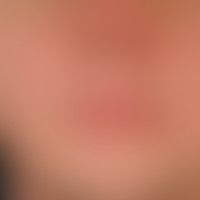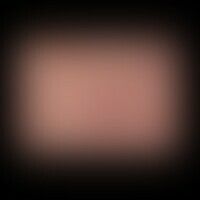Image diagnoses for "Nodules (<1cm)", "Face"
113 results with 250 images
Results forNodules (<1cm)Face

Acne papulopustulosa L70.9
Acne papulopustulosa: in acne-typical distribution, with large-pored skin, few red smooth and excoriated papules and some pustules.

Demodex folliculitis B88.0
Demodex folliculitis: chronic bilateral follicular dermatitis with extensive reddening. Previous rosacea, but for months an unexpected significant worsening of the findings.

Lichen planus (overview) L43.-
Lichen planus actinicus: anularsmaller lesions and merged into larger map-like borderline plaques; in the prominent borderline area the violet shade of lichen "ruber" is found.

Acne excoriée L70.8

Lupus erythematosus systemic M32.9
Systemic lupus erythematosus. acutely occurred facially emphasized symmetrical exanthema with disturbance of the general findings, medium-high fever, rheumatoid complaints. 10 year-old girl.

Leprosy lepromatosa A30.50

Lupus erythematodes chronicus discoides L93.0
Lupus erythematodes chronicus discoides: large, sharply defined plaque with a central, clearly sunken (atrophy of the subcutaneous fatty tissue), poikilodermatic scar; the peripheral zones continue to show inflammatory activity.

Atopic dermatitis in infancy L20.8
Superinfected atopic eczema Chronic atopic eczema with pyodermic plaques on the cheeks and forehead in an infant.

Neurofibromatosis (overview) Q85.0
Type I Neurofibromatosis, peripheral type or classic cutaneous form, numerous smaller and larger soft papules and nodules.

Gianotti-crosti syndrome L44.4
Acrodermatitis papulosa eruptiva infantilis; acute exanthema with disseminated lichenoid papules confluent in the centre of the cheeks in hepatitis B; slight fever with gastrointestinal symptoms (diarrhoea); lymphadenopathy.

Elastoidosis cutanea nodularis et cystica L57.8
Elastoidosis cutanea nodularis et cystica: multiple, chronic inpatient, 0.4 - 1.2 cm large, symptomless, soft, yellowish papules and nodules; black comedones in the temporal region. 72-year-old man with massive chronic UV exposure over decades.

Rosacea L71.1; L71.8; L71.9;
Stage IIrosacea (rosacea papulopustulosa) Stage II rosacea with single, inflammatory papules and pustules on the forehead, nose, cheeks and chin in a 34-year-old female patient.

Basal cell carcinoma (overview) C44.-
Basal cell carcinoma nodular: Irregularly configured, hardly painful, borderline red nodule (here the clinical suspicion of a basal cell carcinoma can be raised: nodular structure, shiny surface, telangiectasia); extensive decay of the tumor parenchyma in the center of the nodule.

Dyskeratosis follicularis Q82.8
Dyskeratosis follicularis. reflected light microscopy: section of a lesion on the neck. yellowish-white keratin plaques (orthohyperkeratosis) and areas with ball-shaped, ectatic central capillaries (acantholysis area).

Lymphoepithelioma-like carcinoma C44.4
Lymphoepithelioma-like carcinoma: unspectacular clinical picture with glassy appearing solid nodules. Fig. taken from Oliveira CC et al. (2018) Lymphoepithelioma-like carcinoma of the skin. An Bras Dermatol 93:256-258.









